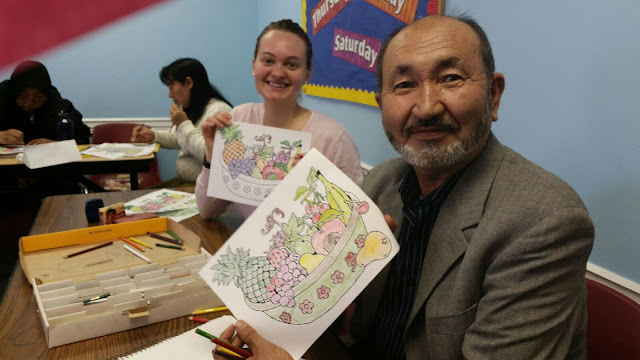Sometimes grammar can just be too much.
That’s why this week, we did something a little different
for my beginner ESL class at the Indo American Center. After learning the names
of various fruits—banana, cherry, pineapple, kiwi— the students and I did a fruits
basket coloring page.
Adult coloring boks are kind of a fad right now, one that I
so far haven’t really gotten into. But the students really seem to enjoy it,
and as I sat coloring with them, I started to see why.
In a world where
problems can seem so nebulous and events so random, the structure of coloring in the lines is refreshing. The only decision you have to make is, should I do this peach first or the pear? Should my grapes be red or green? There is something very
satisfying about taking a half hour out of the week and letting your world
shrink to the size of a piece of paper, your only task to take something drab
and colorless and make it beautiful.
This is especially important for the class I teach because
most of the students are refugees. Not
only are they trying to navigate the mammoth task of living in a foreign country
where they don’t speak the language or have a strong support system, but many
of them are also recovering from the whatever traumatic events forced them to leave home. One student
described being tortured in a Burmese prison, pulling down the collar of his
shirt to reveal long scars puckering the skin of his chest. He used his hands
and face to supplement the few English words he could summon up—no money, pain,
hungry— describing men shooting guns, people dying in front of him. For him, coloring provided an opportunity to temporarily escape from problems bigger than I can even conceptualize.
Of all the students though, Linda enjoyed coloring the most.
Linda is from Iraq, a member of one of the Christian minority groups that have
been systematically persecuted in that country. Once the avid note-taker and vocal
participant, the last two weeks she could hardly make it through a class period
without crying. Today, though, she stayed in her seat long after all the other
students had gone, determined to finish every last apple leaf and cherry stem.
I sat with her and we colored together in silence for nearly twenty minutes.
This was the first time I had seen her smile in two weeks.
That was a really significant moment for me. There’s really
so little I can do for Linda.. I can’t even ask her what’s wrong in words that
she can understand. But at least I could give her a little bit of space and
time away from whatever terrible things make a grown woman come to her English
class crying every day.
I used to have this idea that I needed to do something big and grand to change the world. However, my experience this year is teaching me more and more every day that making the world a better place really happens in ways so small and mundane they can seem like nothing.
In other news, this weekend I attended the St. Patrick's Day parade (featuring troupes of bagpipers, Irish dancers, and various marching bands) and witnessed the Chicago River dyed bright green. It seemed like the entire city went nuts for St. Patrick's Day, Irish and non-Irish alike.





